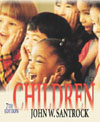John W. Santrock,
University of Texas, Dallas
| basal metabolism rate (BMR) | the minimum amount of energy a person uses in a resting state.
(See 261)
|
 |
 |
 |
| Denver Developmental Screening Test | a test used to diagnose developmental delay in children from birth to 6 years of age; includes separate assessments of gross and fine motor skills, language, and personal-social ability.
(See 257)
|
 |
 |
 |
| design stage | Kellogg's term for 3 to 4-year-olds' drawings that mix two basic shapes into more complex designs.
(See 257)
|
 |
 |
 |
| functional amblyopia | an eye defect that results from not using one eye enough to avoid the discomfort of double vision produced by imbalanced eye muscles; "lazy eye."
(See 254)
|
 |
 |
 |
| myelination | the process in which the nerve cells are covered and insulated with a layer of fat cells, which increases the speed at which information travels through the nervous system.
(See 252)
|
 |
 |
 |
| nightmares | frightening dreams that awaken the sleeper.
(See 260)
|
 |
 |
 |
| night terrors | sudden arousal from sleep, characterized by intense fear and usually accompanied by physiological reactions, such as rapid heart rate and breathing, loud screams, heavy perspiration, and physical movement.
(See 260)
|
 |
 |
 |
| pictorial stage | Kellogg's term for 4 to 5-year-olds' drawings depicting objects that adults can recognize.
(See 257)
|
 |
 |
 |
| placement stage | Kellogg's term for 2 to 3-year-olds' drawings that are drawn in placement patterns.
(See 257)
|
 |
 |
 |
| shape stage | Kellogg's term for 3-year-olds' drawings consisting of diagrams in different shapes.
(See 257)
|
 |
 |
 |
| somnambulism | sleepwalking; occurs in the deepest stage of sleep.
(See 260)
|
 |
 |
 |
| transitional objects | objects that children repeatedly use as bedtime companions. These usually are soft and cuddly and probably mark the child's transition from being dependent to being more independent.
(See 260)
|



 2003 McGraw-Hill Higher Education
2003 McGraw-Hill Higher Education

 2003 McGraw-Hill Higher Education
2003 McGraw-Hill Higher Education